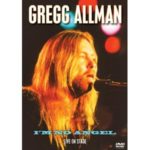
Marketing the I’m No Angel Live on Stage DVD as a Gregg Allman release would seem a wise and timely decision. After all, the golden-haired singer had a great year. Following the publication of his autobiography, a Lifetime Achievement Grammy award, another sold-out run at the Beacon Theatre and successful summer shed tour with The Allman Brothers Band, and a wedding engagement, Allman is as prominent a rock-and-roll figure today as he’s been in 25 years. Yet, the more accurate billing for this hour-long program from 1988 is The Gregg Allman Band, a unit that existed for the half-dozen years between Brothers dissolutions, and it is the band that provides as many if not more highlights than Gregg, himself.
With a track list that reflects the tour in support of their sophomore, and subsequently final album Just Before the Bullets Fly, there are clues that this is more a made-for-TV promotional appearance than a night on the circuit. Opening with a voice-over intro and a dated neon title Live On Stage flashing across the screen, the set was filmed at Nashville’s The Cannery, with multiple camera angles, proper lighting, and a small, mostly unseen but enthusiastic audience. The audio is less than stellar, at times sounding as though one is listening to the band through the hood of a sweatshirt, lending evidence to the notion that this was an episode meant for the small screen, rather than a live concert recorded in high fidelity.
It’s a slight detraction from what is otherwise a real gem of a performance from The Gregg Allman Band, including guitarist ‘Dangerous’ Dan Toler and his late brother drummer David ‘Frankie’ Toler- both of whom having the inauspicious distinction of appearing on The Allman Brothers Band’s forgettable Arista offering Brothers of the Road, just prior to a band break-up in 1982. The sibling duo, who cut their teeth as members of Dickey Betts’ 1970s Great Southern, are no strangers to the catalog, as they nail the opening “Don’t Want You No More/It’s Not My Cross to Bear” couplet, a staple of the Brothers shows dating back to the Duane days. It’s a strong start from an ensemble that knows well the repertoire.
Next, a reworked version of Candi Staton’s “Sweet Feeling” rumbles through its juke-joint paces before the Bullets title track, ballad “Fear of Falling,” and anti-drug grinder “Demons” reach the mid-point. Allman is in classic form here, delivering his signature howls, punchy Hammond organ, and growling, blues-boy vocals, seeming to enjoy his role as complementary player rather than spotlighted.
“I’m No Angel,” the 1987 hit that resurrected Allman’s career, gets a fairly literal reading before diving back into the Brothers canon for “Statesboro Blues.” While the absence of a slide-guitar second line is obvious, Toler’s white-hot fretwork gets a lift from the interplay with Tim Heding’s playful piano. It’s more of a groove than a stomp, more slick than swampy, more arranged than improvised, but one has to remember that at the time there just weren’t any major label artists outside of Stevie Ray Vaughan and Double Trouble even attempting to play this brand of music. Though in appearance and approach, it may contain the trappings of latter-decade style, such as synth horns on “Slip Away” and the indefatigable “One Way Out,” it kept alive a blues that was all but relegated to cut-out bins.
Certainly it doesn’t hurt that the band is Ginsu-sharp. Every break, every fill is note-perfect with the attention mostly on the front three of Allman, Toler, and Heding. Percussion partners David Toler and Chaz Trippy, along with bassist Bruce Waibel, round out a rhythm section in lock-step with the leaders. When the Allman Brothers Band reconvened a year later for 1989’s 20th anniversary tour, Toler’s guitar spot was taken by Warren Haynes, and while that move is above second-guessing, it certainly wasn’t for lack of ability that Dangerous Dan was off the roster. He’s really the star of this show; literally taking center stage, calling off songs, smiling while his fingers fly. With his health recently in decline, to have this performance available is a wonderful reminder of his talent.
The completists among Allman followers should have no trouble arguing for the inclusion of this in the casual fan’s collection, if for no other reason than it is the only currently available document on film of this band. Worth remembering, these musicians and their performances bridged the music’s heyday of the 1970s with the rebirth of the 1990s. While the value of the disc as artifact is unavoidable, it doesn’t diminish its capacity as an entertaining way to spend an hour.



No Comments comments associated with this post